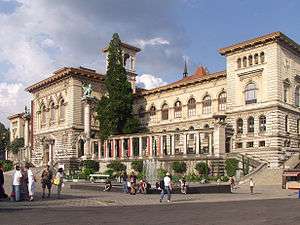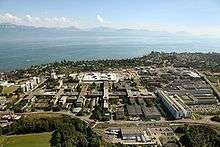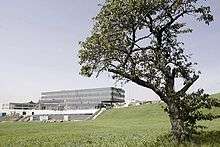University of Lausanne
| Université de Lausanne | |
 | |
| Latin: Schola Lausannensis | |
| Motto | Le savoir vivant |
|---|---|
Motto in English | Live knowledge |
| Type | Public university |
| Established | 1537 |
| Rector |
Prof. Dominique Arlettaz (until July 2016) Nouria Hernandez (since August 2016) |
Administrative staff | 3,700 (2014) |
| Students | 13,500 (2014) |
| Undergraduates | 8,066 (2010) |
| Postgraduates | 1,370 (2010) |
| 1,583 (2010) | |
| Address |
Université de Lausanne, 1015 Lausanne, Suisse, Lausanne, Chavannes-près-Renens, Écublens, Saint-Sulpice and Épalinges, Switzerland 46°31′21″N 6°34′46″E / 46.52250°N 6.57944°ECoordinates: 46°31′21″N 6°34′46″E / 46.52250°N 6.57944°E |
| Affiliations | EUA, AUF, UNICA |
| Website | www.unil.ch |
The University of Lausanne (UNIL, French: Université de Lausanne) in Lausanne, Switzerland was founded in 1537 as a school of theology, before being made a university in 1890. Today about 13,500 students and 2,200 researchers study and work at the university. Approximately 1,500 international students attend the university (120 nationalities), which has a wide curriculum including exchange programs with world-renowned universities.
Since 2005, the University follows the requirements of the Bologna process. The 2011 Times Higher Education World University Rankings[1] ranked the University of Lausanne 116th globally. The CWTS Leiden Ranking 2015 ranks the University of Lausanne 11th in Europe and 41st globally, out of 750 universities.[2]
Together with the École polytechnique fédérale de Lausanne (EPFL) the university forms a vast campus at the shores of Lake Geneva.
Faculties and schools

The University of Lausanne comprises seven faculties:
- Faculty of Arts
- Faculty of Biology and Medicine (FBM)
- Faculty of Business and Economics (HEC), also called HEC Lausanne
- Faculty of Geosciences and Environment (GSE)
- Faculty of Law, Criminal Justice and Public Administration (FDSC), including the Swiss Graduate School of Public Administration
- Faculty of Social and Political Sciences (SSP)
- Faculty of Theology and Religious Studies (FTSR)
The University of Lausanne also comprises schools and different sections, including but not limited to:
- School of Criminal Justice (ESC)
- School of French as a Foreign Language (EFLE)
- French summer and winter courses (Cours de vacances)
- Science-Society Interface
History


The Academy, forerunner of the UNIL, was founded in 1537. Its vocation at that time was to train ministers for the church. The university enjoyed a certain renown due to the fact that it was the only French language Protestant school of theology. As the centuries passed, the number of faculties increased and diversified until, in 1890, the Academy received the name and status of a university.
In 1909 Rodolphe Archibald Reiss founded the first school of forensic science in the world: the Institut de police scientifique.
From 1970, the university moved progressively from the old centre of Lausanne, around the Cathedral and Château, to its present site at Dorigny.
The end of the 20th century witnessed the beginnings of an ambitious project aiming at greater co-operation and development among the French-speaking universities of Lausanne, Geneva, and Neuchâtel, together with the Swiss Federal Institute of Technology in Lausanne (EPFL). Among others, this led to the transfer of the sections of Mathematics, Physics and Chemistry from the University to the EPFL; the funds that were made available following this transfer were invested in the development of the life sciences at the University, including the creation of a Center for Integrative Genomics.
In 2003 two new faculties were founded, concentrating on the life and human sciences: the Faculty of Biology and Medicine and the Faculty of Geosciences and Environment.
On 1 January 2014, the Swiss Graduate School of Public Administration (IDHEAP) was integrated into the University of Lausanne.[3]
Campus
Main campus
The main campus is presently situated outside the city of Lausanne, on the shores of Lake Léman, in Dorigny. It is adjacent to the Swiss Federal Institute of Technology in Lausanne (EPFL) and is served by the Lausanne Metro Line 1 (M1). The two schools together welcome about 20,000 students.
The UNIL and the EPFL share an active sports centre located on the campus, on the shores of Lake Geneva[4] and their campus is also equipped with a bicycle sharing system.[5]
The university campus is made up of individual buildings with a park and arboretum in between. The university library also serves as eating hall and is centrally located. The view from the library across the sports fields to the lake of Geneva and the French and Swiss Alps. On a clear day, Mont Blanc can be seen.
The Swiss Institute of Comparative Law and the central administration of the Swiss Institute of Bioinformatics are also located on the main campus.
 The main building of the Faculty of Law and Criminal Justice and of the Faculty of Business and Economics.
The main building of the Faculty of Law and Criminal Justice and of the Faculty of Business and Economics. The Extranef building.
The Extranef building. The Édouard Fleuret Library pavilion.
The Édouard Fleuret Library pavilion. The Génopode building of the University of Lausanne hosts the Center for Integrative Genomics of the University of Lausanne and the central administration of the Swiss Institute of Bioinformatics.
The Génopode building of the University of Lausanne hosts the Center for Integrative Genomics of the University of Lausanne and the central administration of the Swiss Institute of Bioinformatics. The School of Criminal Justice of the UNIL is the world oldest school of forensic science and is one of the only European institution to offer a complete education in forensic sciences.
The School of Criminal Justice of the UNIL is the world oldest school of forensic science and is one of the only European institution to offer a complete education in forensic sciences. The Anthropole building.
The Anthropole building. Unithèque building houses one of the two sites of the Cantonal and University Library of Lausanne on the main campus of the UNIL
Unithèque building houses one of the two sites of the Cantonal and University Library of Lausanne on the main campus of the UNIL The Swiss Institute of Comparative Law, on the campus of the University of Lausanne.
The Swiss Institute of Comparative Law, on the campus of the University of Lausanne. The Géopolis building on the main campus housing the Social and Political Sciences and the Geo- and Environmental Sciences.
The Géopolis building on the main campus housing the Social and Political Sciences and the Geo- and Environmental Sciences. The Swiss Federal Institute of Technology in Lausanne (EPFL) (photo) and the University of Lausanne form a large campus near the lake Geneva.
The Swiss Federal Institute of Technology in Lausanne (EPFL) (photo) and the University of Lausanne form a large campus near the lake Geneva.
Other sites
In addition to its main campus at the lakeside, the University of Lausanne also has other sites. The Faculty of Biology and Medicine is also located in two other sites: around the University Hospital of Lausanne (CHUV) (site called Bugnon) and in Épalinges (to the north of Lausanne).
The Department of Biochemistry, the Ludwig Cancer Research branch of the University of Lausanne and the WHO Immunology Research and Training Centre and some laboratories of the University Hospital of Lausanne are located in Épalinges. The Biopôle was built next to the Épalinges campus. The Faculty of Biology and Medicine also comprises a fourth site, the Psychiatric Hospital of Cery, in Prilly.
 Bugnon 21, headquarters of the University Hospital of Lausanne and of the deanship of the Faculty of Biology and Medicine.
Bugnon 21, headquarters of the University Hospital of Lausanne and of the deanship of the Faculty of Biology and Medicine.
Associated institutions

- Kurt Bösch Institute (IUKB)
- International Institute for Management Development (IMD)
- Jean Monnet Foundation for Europe
- Swiss Institute of Comparative Law
- Centre du droit de l'entreprise (CEDIDAC)
- Fondation Edouard Fleuret (FEF)
- Swiss Centre of Expertise in the Social Sciences
- Swiss Cancer Centre
- Swiss Institute for Experimental Cancer Research (ISREC)
- Ludwig Cancer Research
- WHO Immunology Research and Training Centre
- Swiss Institute of Bioinformatics (SIB)
- Swiss Vaccine Research Institute[6]
- Center for Biomedical Imaging (CIBM)[7]
- Centre for Advanced Modelling Science (CADMOS)[8]
- Institut universitaire romand de santé au travail (IST)[9]
- École romande de santé publique (ERSP)
- University Centre of Legal Medicine (CURML)[10]
- Biopôle
- Jules Gonin Eye Hospital
- International Academy of Sport Science and Technology (AISTS)
- Swiss School of Archaeology in Greece
- Institut romand des sciences bibliques (IRSB)
- Centre de recherches sur les lettres romandes (CRLR)
- Institut Benjamin Constant (IBC)
Reputation and rankings

The University of Texas at Dallas TOP 100 BUSINESS SCHOOL RESEARCH RANKINGS ranked the Faculty of Business & Economics of the University of Lausanne (HEC Lausanne) as follows:
| Period | In Switzerland | In Europe | In the World |
|---|---|---|---|
| 2004-2008 | 1st | 9th | 112th |
| 2003-2007 | 1st | 8th | 103rd |
| 2002-2006 | 1st | 8th | 123rd |
| 2001-2005 | 1st | 14th | 149th |
| 2000-2004 | 1st | 20th | 186th |
The Times Higher Education World University Rankings[1] ranked the University of Lausanne as follows:
| Year | In Switzerland | In Europe | In the World |
|---|---|---|---|
| 2013-2014 | 6th | 54th | 132nd |
| 2012-2013 | 4th | 51st | 130th |
| 2011-2012 | 6th | 41st | 116th |
| 2010-2011 | 6th | 44th | 136th |
The QS World University Rankings[11] ranked the University of Lausanne as follows:
| Year | In Switzerland | In Europe | In the World |
|---|---|---|---|
| 2013 | 6th | - | 111th |
| 2012 | 6th | - | 115th |
| 2011 | 5th | - | 136th |
| 2010 | 6th | - | 152nd |
The THE-QS World University Rankings (in 2010 Times Higher Education World University Rankings and QS World University Rankings parted ways to produce separate rankings) ranked the University of Lausanne as follows:
| Year | In Switzerland | In Europe | In the World |
|---|---|---|---|
| 2009 | 6th | - | 168th |
| 2008 | 6th | 64th | 161st |
| 2007 | 7th | 93rd | 217th |
| 2006 | 5th | - | 89th |
| 2005 | 6th | - | 133rd |
The Academic Ranking of World Universities [ARWU] ranked the University of Lausanne as follows:
| Year | In Switzerland | In Europe | In the World |
|---|---|---|---|
| 2014 | 6th-7th | ? | 151st - 200th |
| 2013 | 7th | ? | 201st - 300th |
| 2012 | 7th | ? | 201st - 300th |
| 2011 | 7th | ? | 201st - 300th |
| 2010 | 7th | 75th - 123rd | 201st - 300th |
| 2009 | 7th | 80th - 125th | 201st - 302nd |
| 2008 | 7th | 80th - 124th | 201st - 302nd |
| 2007 | 7th | 81st - 123rd | 203rd - 304th |
| 2006 | 7th | 79th - 122nd | 201st - 300th |
| 2005 | 7th | 124th - 168nd | 301st - 400th |
| 2004 | - | - | 302nd - 403rd |
| 2003 | - | - | 301st - 350th |
The Leiden Ranking of the University of Leiden, when ranking universities by the size-independent, field-normalized average impact of their research publications (CPP/FCSm) among the 250 largest universities worldwide, ranked the University of Lausanne as follows:
| Year | In Switzerland | In Europe | In the World |
|---|---|---|---|
| 2010 | 3rd | 5th | 45th |
| 2008 | 3rd | 6th | 73rd |
The Leiden Ranking of the University of Leiden, when ranking universities by citations-per-publication (CPP) among the 250 largest universities worldwide, ranked the University of Lausanne as follows:
| Year | In Switzerland | In Europe | In the World |
|---|---|---|---|
| 2010 | 1st | 1st | 22nd |
| 2008 | 1st | 1st | 31st |
4 International Colleges & Universities [4icu.org] ranked the popularity of the website of the University of Lausanne as follows:
| Year | In Switzerland | In Europe | In the World |
|---|---|---|---|
| 2009 | 5th | 15th | 45th |
Press
The UNIL publish free monthly campus magazine entitled L'Uniscope. The UNIL also publish Allez savoir !, a magazine aimed at a larger audience (general public), published three times a year (in May, September and January) and whose subscription is free.
Besides these, L'auditoire is the students newspapers from both UNIL and EPFL, of a circulation 19 000 free copies.
Alumni
ALUMNIL network
In 2011, an on-line network of the UNIL alumni, called ALUMNIL, was created.[12] Since then, regular events (throughout the year) and an annual party (in autumn) are organised every year for the alumni.
Royalty
- King Ananda Mahidol (Rama VIII) of Thailand
- King Bhumibol Adulyadej (Rama IX) of Thailand
- Princess Galyani Vadhana of Thailand
- Prince Bernhard of the Netherlands
- Princess Vera Ignatievna Giedroyc, Lithuanian princess and Russian-Ukrainian surgeon
Politics
- Daniel-Henri Druey, President of the Swiss Confederation
- Constant Fornerod, President of the Swiss Confederation
- Paul Ceresole, President of the Swiss Confederation
- Antoine Louis John Ruchonnet, President of the Swiss Confederation
- Eugène Ruffy, President of the Swiss Confederation
- Marc-Emile Ruchet, President of the Swiss Confederation
- Ernest Chuard, President of the Swiss Confederation
- Marcel Pilet-Golaz, President of the Swiss Confederation
- Georges-André Chevallaz, President of the Swiss Confederation
- Pascal Couchepin, President of the Swiss Confederation
- Jean-Pascal Delamuraz, President of the Swiss Confederation
- İsmail Cem, Minister of Foreign Affairs of Turkey
- Şemsettin Günaltay, Prime Minister of Turkey
- Fazıl Küçük, first Vice President of the Republic of Cyprus
- Pascoal Mocumbi, Prime Minister of Mozambique
- Mohammad Sa'ed, Prime Minister of Iran
- Jonas Savimbi, leader of UNITA, an anti-Communist rebel group in Angola
- Lutz Graf Schwerin von Krosigk, Leading Minister of the German Reich
- Max Huber, Swiss international lawyer and diplomat, President of the International Committee of the Red Cross
Business
- Jean-Claude Biver, CEO of Hublot
- Louis C. Camilleri, CEO of Philip Morris International
- Jean Claude Gandur, CEO of Addax Petroleum[13]
More alumni from the Faculty of Business and Economics
Literature
- Mohammad-Ali Jamalzadeh, prominent Iranian writer
- Edmond Pidoux, Swiss poet and novelist
- Charles Ferdinand Ramuz, Swiss writer
- Philippe Jaccottet, Swiss poet
Scholars
- Jean de Serres (1540 - 1598), French humanist, Plato translator, Calvinist
- Leo Aryeh Mayer, rector of the Hebrew University of Jerusalem
- Jean Piccard, Swiss-born American chemist, engineer, professor and high-altitude balloonist
- Alexandre Yersin, Swiss-French physician, co-discoverer of the bacillus responsible for the bubonic plague
- Luc E. Weber, Rector Emeritus of the University of Geneva
- Georges de Rham, Swiss mathematician, known for his contributions to differential topology
Others
- Sepp Blatter, President of FIFA
- Akbar Etemad, president of the Atomic Energy Organisation of Iran
- Christophe Keckeis, Head of the Swiss Army
- Claude Nicollier, Swiss astronaut
- Bertrand Piccard, Swiss psychiatrist and balloonist
- Nikolaus Senn (1926–2014), co-director of Schweizerische Bankgesellschaft
School of Lausanne
Neoclassical school of thought in economics founded at the University of Lausanne by two of its professors: Léon Walras and Vilfredo Pareto. The School of Lausanne is associated with the development of general equilibrium theory as well as the marginalist revolution Marginalism.
See also
- Charles Guillaume Loys de Bochat
- List of largest universities by enrollment in Switzerland
- List of modern universities in Europe (1801–1945)
- List of universities in Switzerland
- Cantonal and University Library of Lausanne
- International Academy of Sport Science and Technology (AISTS)
- Jean Monnet Foundation for Europe
- Swiss School of Archaeology in Greece
- University Hospital of Lausanne (CHUV)
Notes and references
- 1 2 "Times Higher Education World University Rankings".
- ↑ CWTS Leiden Ranking 2015
- ↑ Rapport annuel 2012 de l'Université de Lausanne, www.unil.ch (page visited on 30 May 2013).
- ↑ Service des sports UNIL-EPFL, sport.unil.ch (page visited on 10 May 2013).
- ↑ Campus roule, www.publibike.ch (page visited on 15 May 2013).
- ↑ Swiss Vaccine Research Institute (page visited on 14 April 2012).
- ↑ Center for Biomedical Imaging (page visited on 2 October 2011).
- ↑ CADMOS (page visited on le 20 February 2012).
- ↑ Institut universitaire romand de santé au travail (page visited on 1 October 2011).
- ↑ Centre universitaire romand de médecine légale (page visited on 3 June 2012).
- ↑ "QS World University Rankings 2010 Results".
- ↑ ALUMNIL, www.unil.ch (page visited on 1 November 2013).
- ↑ "Jean Claude Gandur". Fg-art.org. Retrieved 6 November 2014.
See also
| Wikimedia Commons has media related to University of Lausanne. |
Bibliography
- (French) Jean-Philippe Leresche, Frédéric Joye-Cagnard, Martin Benninghoff and Raphaël Ramuz, Gouverner les universités. L'exemple de la coordination Genève-Lausanne (1990-2010), Presses polytechniques et universitaires romandes, 2012 (ISBN 9782880749316).
- (French) Nadja Maillard, L'Université de Lausanne à Dorigny, Éditions Infolio, 488 pages, 2013 (ISBN 978-2-88474-280-1).
External links
- (English) Official website
- (French) Cantonal and University Library of Lausanne
- University of Lausanne in rankings
- Video to welcome new students on YouTube
